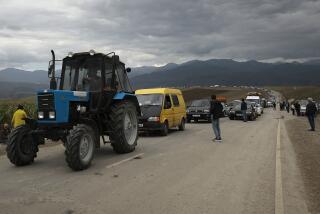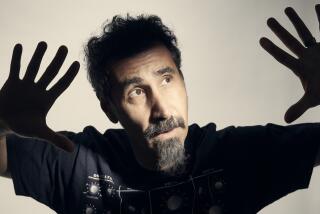Community Comment : ‘There’s Always the Danger of Culture Being Lost’
- Share via
For the principal of the Armenian Mesrobian School in Pico Rivera, the Armenian genocide of 1915 by the Ottoman Turks was the defining moment. That holocaust is said to have claimed the lives of more than 1.5 million people while scattering an entire race across the globe. Among Ghoogasian’s chief goals as an educator is to instill in the students an appreciation for the tradition, culture and language of the Armenian people.
We want to awaken in the kids a sense of their heritage, their language, from where they come, why they are here. All of those things.
The philosophy here is to give a quality education in the American sense as well as to make sure that the Armenian heritage is preserved. Because it is a very rich culture and heritage. It’s centuries old. For example, Armenians were the first to accept Christianity as their national religion.
We teach Armenian dance, Armenian cooking, religion, Armenian drama, Armenian history and the language. Even our Armenian (language) classes are certified by the University of California.
We are a small community school. That’s kind of what makes us special.
There’s already a built-in sense of community because these kids grow up together. We have students from preschool through the 12th grade. There’s a kinship between the teachers and between the teachers and the students. The kids see the same teachers every year. The head of our early childhood education department and kindergarten homeroom teacher is the same person who has taught kindergarten since the opening of the school in 1965.
There have been kids here from Lebanon, from Iran, Iraq and from all different areas of the United States. But that sense of Armenianism ties them together. We feel close to one another. A lot of our graduates are active in the community. We have some alumni who teach here. We try to give back some of what we’ve been given. This sort of commitment also makes our school unique.
My first experience here was in September of 1969 when, as a 4-year-old, I entered kindergarten. From kindergarten through the 12th grade, I formed lifetime friendships with the people in my class and other schoolmates. It was at the Armenian Mesrobian School that I met my wife. There have been quite a number of marriages whose roots can be traced to this school, and children of Mesrobian alumni are now attending.
But there’s always the danger of the culture being lost. We see that it is being lost more and more. Once you stay in a nation that is not “your own” for awhile, you are obviously going to assimilate. These (Armenian) schools and churches are intended to keep that heritage.
When Armenians settle someplace, the first thing they do is build a church. Armenians have always clung to religion, not only for its spiritual value but also as a component of their national identity. And if they thought they were going to be there awhile, they built a school.
That’s why these Armenian schools have popped up all over the world. Particularly after the genocide, when Armenians were displaced all over and there was no definite time frame when they would return to Armenia, or if they would return to Armenia.
So these institutions were set up to preserve the culture until it was time to go back (to Armenia). It was always intended to be temporary. It was just a means to an end.
Armenians have survived for all of these centuries, sometimes without a homeland, because we’ve had a strong ethnic identity. Armenians have traditionally been a kind of refugee people, particularly since 1915. Even as we speak right now, what’s happening in Azerbaijan is a threat to us as a people.
More to Read
Sign up for Essential California
The most important California stories and recommendations in your inbox every morning.
You may occasionally receive promotional content from the Los Angeles Times.










